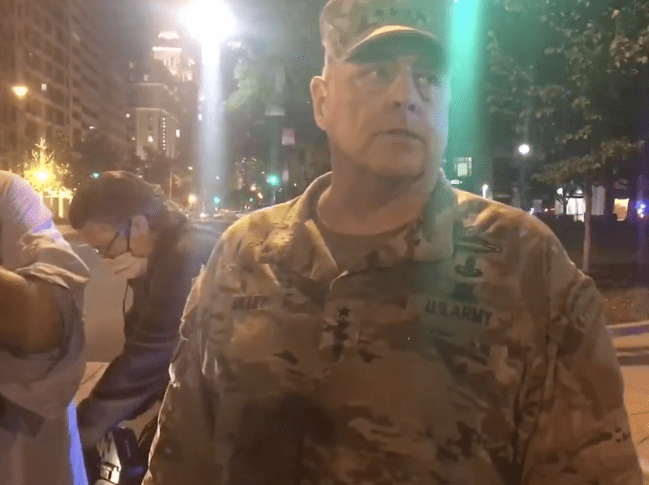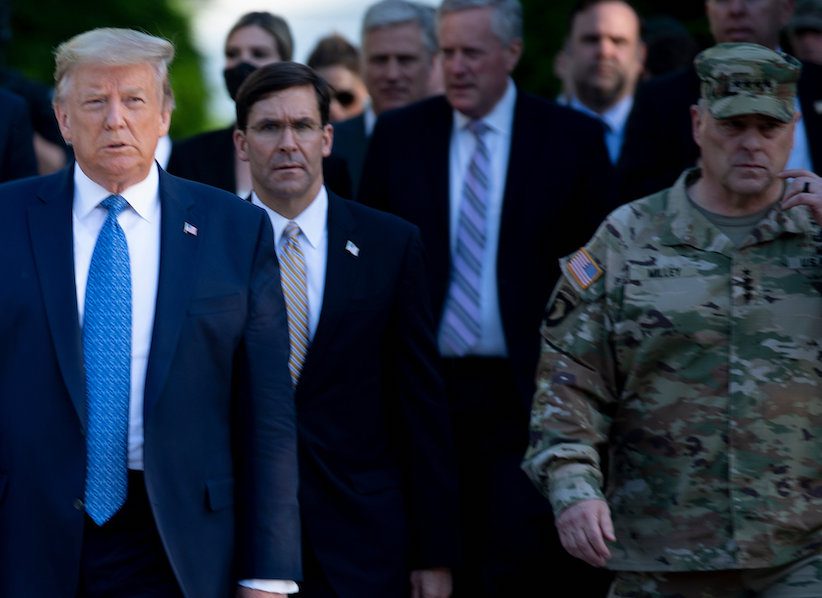General Milley Checks on His Troops…On the Streets of D.C.

There is nothing more cringe than a political photo op, but when the President of the United States sends his Secretary of Defense and Chairman of the Joint Chiefs of Staff out onto the streets during political protests it becomes a bit unnerving, too.
The stagecraft started Monday afternoon with the president leaving the White House grounds with the two aforementioned cabinet officials, along with Attorney General Bob Barr, his son-in-law Jared Kushner, and assorted White House staff, to the historic St. John’s Church, where he held up a bible. Demonstrators had set fire to the church and the basement had sustained damage the night before.
In order to clear the way for this sojourn, police had used teargas and batons on the largely peaceful protesters outside the White House in the late Monday afternoon sun.

He finished the evening by addressing the nation, announcing he would be deploying federal troops “to stop the rioting, looting, vandalism, assaults and the wanton destruction of property,” he said. “We will end it now.” He said the military would exert “total domination” over the situation. Again, flash bangs could be heard and smell of tear gas in the air as protesters were dispersed just before the D.C. curfew.
Later there were reports that upwards of 250 military police from Ft. Bragg had been activated for the mission.
Earlier, Secretary of Defense Mark Esper called it “dominating the battlespace.” Senator Tom Cotton, a combat veteran and hawk of first order, said in a Tweet, that “if necessary, the 10th Mountain, 82nd Airborne, 1st Cav, 3rd Infantry—whatever it takes to restore order. No quarter for insurrectionists, anarchists, rioters, and looters.”
Later Esper and General Milley were seen walking the streets, giving interviews, shaking hands with police.
Milley, donned in his fatigues, told reporters he was “checking” to see how well the deployed D.C. National Guard were doing and said “everyone has the right to protest …. But protest peacefully.”
According to reports some 1,700 DC Guard have been called up and were moving into the city over the weekend. Because D.C. is a federal district, not a state, there was no need to federalize them, they are already under the chain of command. As an aside, Trump put Milley in charge of the “response,” but as Chairman of the Joint Chiefs he is not in the military’s operational chain of command so it is not clear what exactly that role will be.
General Milley, chairman of the joint chiefs of staff, walking the streets of Washington DC right now. Briefly spoke to say he is observing the situation. pic.twitter.com/fHcYOTYMzN
— Shabtai (@velvetart) June 2, 2020
It was a rough night Sunday for sure, with a number of businesses broken into, fires lit, buildings and monuments, including the Lincoln and WWII Memorials, spray-painted and defaced. But this isn’t a war and the “soldiers” hadn’t been in the “battlespace” for more than 48 hours. The moment hardly called for a moral boost akin to stoking the troops after the Battle for Baghdad. This was a Trump photo op and Milley and Esper were a command performance.
So what do we at home see? That depends on who you ask. Many Americans, watching the wretched violence on TV and You Tube—store owners in major U.S. cities beaten as they businesses are looted, vehicles smashed, neighborhoods smoldering—will commend the president for taking a stand, calling himself “the law and order president.” They will have no reservations about calling in the military for D.C. or if the president decided to invoke the Insurrection Act to send troops into more volatile cities like Minneapolis and Los Angeles.
Others will look back at the other 12 times presidents used federal troops on domestic soil—the most recent, the Rodney King riots in L.A.—and wonder if Trump’s move is more symbolism than necessity. In Los Angeles in 1992 the city had been on fire for three days and after 5 days, more than 3,700 buildings were torched, a $1 billion worth of damage caused, and 60 people dead. As disturbing the images coming from D.C. over the last few nights are, there is no comparison.
But the symbolism cuts both ways: Milley walking around DC like John McCain in Iraq in 2007—sans helmet, to prove it’s not so bad—after accompanying the president on a cheesy photo op in which protesters had to be forcibly cleared for the cameras, makes him look like a political tool. Esper too, looks like, as one friend noted to me, part of Trump’s “personal praetorian guard.”
It also sends a message, I’m afraid, that we suddenly have an occupying army. This tends to rub some Americans the wrong way. It’s kind of in our DNA. We have accepted, for good or bad, that the laws allow this incursion from time to time but also, that it has often, like President Hoover calling on Gen. MacArthur to bulldoze the World War I Bonus Army marchers, pitted the Army against its own citizens.
And when Esper starts using words like “battlespace” and police taunt citizens by calling out “light ‘em up” while paint balling their neighborhood, it is an uncomfortable reminder of how wide that civ-mil gap has become since 9/11. And how the significance here can be much more powerful than a silly Trump photo op. And not in the way Trump expected.